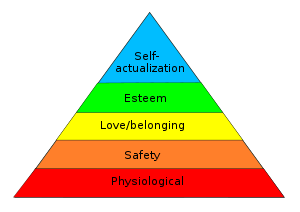
Continuing our look at Postrel's book THE SUBSTANCE OF STYLE.
There is a theory known to undergraduate psychology students as the "hierarchy of needs."
It is the notion, associated with the psychologist Abraham Maslow, who formulated it in the middle of the last century, that the lower level needs must be satisfied before one's attention turns to the level of needs next up. One secures a place to defecate before one even goes looking for food. One has to have a certain level of material comfort, including at least a diminution of hunger pangs, before one moves on to looking for a mate, developing friendships, joining clubs, etc. And so forth upwards to such lofty goals as self-actualization and "transcendence."
At first glance, one might take some of what Postrel says as in accord with this notion. After all, the "aesthetic age" upon which we have entered seems to be a matter of concern chiefly with the wealthier nations, nations where relatively few people don't know where their next meal is coming from. Perhaps the industrialized world is entering an aesthetic age because it has moved a bit up the hierarchy, collectively if not merely in the case of the least well off.
But no ... Postrel is not Maslovian. It is NOT true that we have a meta-need to deal with more fundamental needs before we can or should turn to the making-special of our lived environments. Rather, "Poor people built the cathedrals of Europe and developed the sand castles of Tibet. Poor people turned baskets and pottery into decorative art." etc.
The move into what is called "modernist" architecture, which involved a spurning of aesthetic matters, a functionality-is-all dogma, did not come about as a matter of poverty There was an element of fashion to it. It was an aesthetic reaction against the aesthetic, so to speak. And since then, pomo architecture has moved back toward the embrace of style and stylishness, in ways that annoy some, delight others, and comfort a third group. Maslow' theory doesn't work as a basis for developmental sequence.
Nonetheless, I have illustrated this post with one graphic illustration of the hierarchy of needs. Just because I can.
Comments
Post a Comment